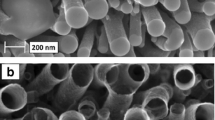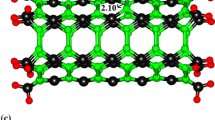Abstract
Modification of boron-carbon nanotubes (BCNTs) by functional groups is an urgent task in relation to the intensive development of the nanoindustry, in particular, nano- and microelectronics. A nanotube modified in this way can be used as an element of a sensor device for detecting trace amounts of various substances, for example, metals that make up salts and alkalis. The paper discusses the possibility of creating a high-performance sensor based on a single-layer boron-carbon BC5 nanotube, surface-modified with a functional amine group (–NH2). The results of quantum chemical studies show that the functional amine group is attached to a BCNT of the (6, 0) type at a distance of 0.16 nm (when modified to both a surface carbon atom and a boron atom), and to BCNT of the type (6, 6), at a distance of 0.16 nm when a group is attached to a carbon atom and 0.17 nm when attached to an atom, which indicates the emergence of a chemical bond between the investigated BCNT and amine group. The results of the computer simulation of the interaction between a surface-modified BC5 nanotube and alkali metal atoms (lithium, sodium, potassium) to be initialized are presented. The sensory interaction of a modified boron-carbon nanosystem with metal atoms is studied, in which the the selected atoms are identified at a certain distance. During the interaction with alkali metal atoms in the BC5 + NH2 complex, the number of carriers increases due to the transfer of electron density from metal atoms to the modified BCNT. The results presented in this article are obtained in the molecular cluster model by quantum-chemical calculations using the DFT calculation method with the exchange-correlational functional B3LYP (split-valence basis set 6-31G). It is proved that the amine-modified boron-carbon BC5 of the nanotube exhibits a sensory response to these alkali metal atoms and can be used as an element of a sensing device.


Similar content being viewed by others
REFERENCES
Dresselhaus, M.S., Dresselhaus, G., and Eklund, P.C., Science of Fullerenes and Carbon Nanotubes, London: Academic, 1996.
Saito, R., Dresselhaus, M.S., and Dresselhaus, G., Physical Properties of Carbon, London: Imperial College Press, 1998.
Zaporotskova, I.V., Uglerodnye i neuglerodnye nanomaterialy i kompozitnye struktury na ikh osnove: stroenie i elektronnye svoistva (Carbon and Non-Carbon Nanomaterials and Composite Structures Based on Them: Structure and Electronic Properties), Volgograd: VolSU, 2009.
Mohamed A.E.-M.A. and Mohamed, M.A., Carbon nanotubes: synthesis, characterization, and applications, in Carbon Nanomaterials for Agri-Food and Environmental Applications, Amsterdam: Elsevier, 2019, pp. 21–32. https://doi.org/10.1016/B978-0-12-819786-8.00002-5
Arunkumar, T., Karthikeyan, R., Ram Subramani, R., Viswanathan, K., and Anish, M., Synthesis and characterisation of multi-walled carbon nanotubes (MWCNTs), Int. J. Ambient Energy, 2020, vol. 41, no. 4, pp. 452–456. https://doi.org/10.1080/01430750.2018.1472657
Tomilin, O.B., Rodionova, E.V., Rodin, E.A., Poroshina, M.D., and Frolov, A.S., The effect of carbon nanotube modifications on their emission properties, Fullerenes Nanotubes Carbon Nanostruct., 2020, vol. 28, no. 2, pp. 123–128. https://doi.org/10.1080/1536383X.2019.1680978
Savin, A.V. and Savina, O.I., An effect of chemical modification of surface of carbon nanotubes on their thermal conductivity, Phys. Solid State, 2019, vol. 61, no. 2, pp. 279–284. https://doi.org/10.1134/S1063783419020252
Dresselhaus, M.S., Dresselhaus, G., and Avouris, P., Carbon Nanotubes: Synthesis, Structure, Properties, and Application, Berlin: Springer, 2000.
D’yachkov, P.N., Elektronnye svoistva i primenenie nanotrubok (Electronic Properties and Use of Nanotubes), Moscow: BINOM. Labor. Znanii, 2010.
Wojtkiewicz, J., Brzostowski, B., and Pilch, M., Electronic and optical properties of carbon nanotubes directed to their applications in solar cells, in Proceedings of the PRAM 2019 Conference: Parallel Processing and Applied Mathematics, Poland, 2020, pp. 341–349. https://doi.org/10.1007/978-3-030-43222-5_30
Suhito, I.R., Koo, K.-M., and Kim, T.H., Recent advances in electrochemical sensors for the detection of biomolecules and whole cells, Biomedicines, 2021, vol. 9, no. 1, pp. 1–20. https://doi.org/10.3390/biomedicines9010015
Park, S.H., Bai, S.-J., and Song, Y.S., Improved performance of carbon nanotubes embedded photomicrobial solar cell, Nanotechnology, 2020, vol. 31, no. 11, p. 115401. https://doi.org/10.1088/1361-6528/ab5b2a
Liu, H. and Li, Y., Modified carbon nanotubes for hydrogen storage at moderate pressure and room temperature, Fulleren. Nanotubes Carbon Nanostruct., 2020, vol. 28, no. 8, pp. 663–670. https://doi.org/10.1080/1536383X.2020.1738396
Manut, A., Zoolfakar, A.S., Mamat, M.H., Ab Ghani, N.S., and Zolkapli, M., Characterization of titanium dioxide (TiO2) nanotubes for resistive-type humidity sensor, in Proceedings of the IEEE International Conference on Semiconductor Electronics ICSE, Vietnam, 2020, pp. 104–107. https://doi.org/10.1109/ICSE49846.2020.9166854
Aydın, M.T.A. and Hoşgün, H.L., Hydrothermal synthesis and characterization of vanadium-doped titanium dioxide nanotubes, J. Austral. Ceram. Soc., 2020, vol. 56, no. 2, pp. 645–651. https://doi.org/10.1007/s41779-019-00382-y
Hussain, R.A. and Hussain, I., Metal telluride nanotubes: Synthesis, and applications, Mater. Chem. Phys., 2020, vol. 256, p. 123691. https://doi.org/10.1016/j.matchemphys.2020.123691
Fujisawa, K., Hayashi, T., Endo, M., Terrones, M., Kim, J.H., and Kim, Y.A., Effect of boron doping on the electrical conductivity of metallicity-separated single walled carbon nanotubes, Nanoscale, 2018, vol. 10, no. 26, pp. 12723–12733. https://doi.org/10.1039/c8nr02323a
Liu, Y., Khavrus, V., Lehmann, T., Yang, H.-L., Stepien, L., Greifzu, M., Oswald, S., Gemming, T., Bezugly, V., and Cuniberti, G., Boron-doped single-walled carbon nanotubes with enhanced thermoelectric power factor for flexible thermoelectric devices, ACS Appl. Energy Mater., 2020, vol. 3, no. 3, pp. 2556–2564. https://doi.org/10.1021/acsaem.9b02243
Fakhrabadi, M.M.S., Allahverdizadeh, A., Norouzifard, V., and Dadashzadeh, B., Effects of boron doping on mechanical properties and thermal conductivities of carbon nanotubes, Solid State Commun., 2012, vol. 152, no. 21, pp. 1973–1979. https://doi.org/10.1016/j.ssc.2012.08.003
Rubio, A., Formation and electronic properties of BC3 single-wall nanotubes upon boron substitution of carbon nanotubes, Phys. Rev. B, 2004, vol. 69, p. 245403. https://doi.org/10.1103/PhysRevB.69.245403
Debnarayan, J., Sun, C.-L., Chen, L.-C., and Chen, K.-H., Effect of chemical doping of boron and nitrogen on the electronic, optical, and electrochemical properties of carbon nanotubes, Prog. Mater. Sci., 2013, vol. 58, p. 565. https://doi.org/10.1016/j.pmatsci.2013.01.003
Boroznina, N.P., Boroznin, S.V., Zaporotskova, I.V., Kozhitov, L.V., and Popkova, A.V., On the practicability of sensors based on surface carboxylated boron-carbon nanotubes, Russ. J. Inorg. Chem., 2019, vol. 64, no. 1, pp. 74–78. https://doi.org/10.1134/S0036023619010029
Boroznina, N.P., Zaporotskova, I.V., Boroznin, S.V., and Dryuchkov, E.S., Sensors based on amino group surface-modified CNTs, Chemosensors, 2019, vol. 7, no. 1, p. 11. https://doi.org/10.3390/CHEMOSENSORS7010011
Koch, W. and Holthausen, M.C., A Chemist’s Guide to Density Functional Theory, Weinheim: Wiley-VCH, 2001.
Rassolov, V.A., Ratner, M.A., Pople, J.A., Redfern, P.C., and Curtiss, L.A.J., 6-31G* basis set for third-row atoms, J. Comput. Chem., 2001, vol. 22, no. 9, pp. 976–984. https://doi.org/10.1002/jcc.1058
Author information
Authors and Affiliations
Corresponding author
Rights and permissions
About this article
Cite this article
Zaporotskova, I.V., Dryuchkov, E.S., Boroznina, N.P. et al. Surface-Modified Boron-Carbon BC5 Nanotube with Amine Group as a Sensor Device Element: Theoretical Research. Russ Microelectron 50, 644–648 (2021). https://doi.org/10.1134/S1063739721080096
Received:
Published:
Issue Date:
DOI: https://doi.org/10.1134/S1063739721080096




